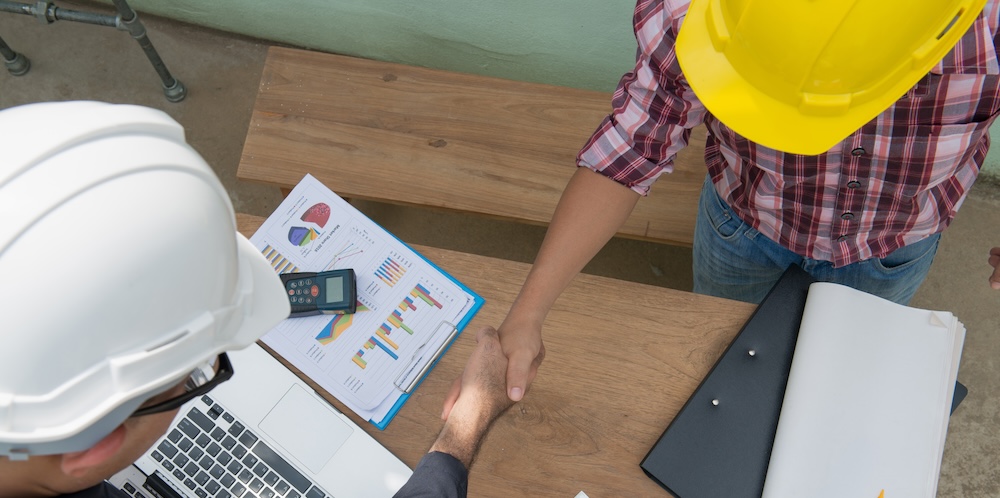— 5 min read
Understanding Subcontractor Bid Packages in Construction
Last Updated Apr 18, 2025
Last Updated Apr 18, 2025

Construction bid packages can have a cascading impact on the success of a construction project. The quality of a bid project may affect the quality of the bids, which in turn can impact the project budget and the final outcomes of the work.
This article will discuss the importance of bid packages in the contractor-subcontractor relationship, the steps involved in creating a bid package and how contractors can effectively hire the best subcontractors for their projects.
Table of contents
What are subcontractor bid packages?
A subcontractor bid package is a collection of documents prepared by the general contractor to solicit bids from potential specialty contractors to work as subcontractors on specific elements as part of a construction project.
Subcontractor bid packages are designed to provide potential subcontractors with all the necessary information to accurately prepare and submit their proposals. Well-constructed bids help create clarity and alignment between the general contractor's expectations and the subcontractor's capabilities, create a basis for comparison between bids and help general contractors select the best subcontractors for the project.
Key Items to Include in a Subcontractor Bid Package
Project Specifications and Scope of Work
The bid package should include all the relevant details about the project, including its name, location, ownership and the contributing design team.
The package should detail the full scope of work, including materials and equipment required to do the work. Project timelines, milestones and deadlines should be clear.
Architectural and Engineering Drawings
Bid packages include detailed plans and blueprints that show in detail system requirements and layout. Construction drawings show the project design in detail, and often go on to become part of the construction contract documents.
Project Safety Requirements
The bid package will include details about the project’s safety requirements, including safety training or certifications needed, and the general contractor’s established project safety plan.
Bid Forms and Instructions
Contractors instruct bidders on how and when to submit their completed bids. Bids are often expected to be presented in a specific format so that they can be compared easily. There will also be a specific deadline included, and any bidding software requirements.
Contract Terms
The bid package may include a copy of the general contractor-subcontractor agreement, which will give details about payment timelines, milestones and legal expectations and give the subcontractor an idea of the expectations of the partnership.
How to Put Together a Bid Package
Define the scope of work.
The scope of work describes what it will take to turn drawings and specifications into a completed structure. It needs to be as clear and detailed as possible so that subcontractors know the requirements of the job. The scope of work should describe the project objectives, detail specific tasks, specify required materials and standards, outline milestones and timelines and incorporate compliance and safety requirements.
Divide the scope of work into work packages.
Break down the project into major components and tasks. Categorize these tasks by trade or specialty, define deliverables for each package, and assign responsibilities to ensure clarity and accountability.
Assemble the bid package.
Compile all necessary documents, including drawings, specifications and requirements. Decide on the prescribed bid forms and instructions for submission, including what bidding software should be used, method of submission and deadlines. Review the package for completeness and accuracy before distribution.
Distribute packages to prequalified bidders.
General contractors often preselect a set of subcontractor businesses that will be asked to bid on a project, based on a set of criteria that proves their ability to handle the project. Once the bid package is ready, GCs distribute it to the shortlist of qualified candidates, evaluate the submitted bids on various criteria and select the best-fit subcontractor.
How are subcontractors prequalified?
A project owner or general contractor may evaluate potential subcontractors to identify those that might be the best fit for working on a coming project. Subcontractor prequalification may be based on many criteria, including the following:
Experience
Has the contractor completed similar work in the past? A history of quality work and rave reviews from partnering contractors can go a long way.
Financial Stability
Does the sub have the capacity to complete the work? Does the company have solid credit reports and bank references?
Safety Record
The company’s safety history, policies and procedures can play a big part in assessing its risk profile.
Workload Flexibility
Is the subcontractor already committed to too many other projects? Is there an available workforce and resources to handle more work?
Tips for Bidding as a Subcontractor
Bidding can be tough work — it takes a whole lot of ground work, and in the end, the bid-hit ratio for construction projects can be as low as 1:5. However, since it’s the straight line to winning new work, subs need to put their best foot forward in project bids, making a clear case for their selection. Here are some of the ways subs can create a solid bid.
Understand the bid package.
Subcontractors shouldn’t assume anything when it comes to the project bid package. Ask questions, attend any available pre-bid meetings, read all the documents thoroughly and do the work to understand all the project parameters.
Break down the numbers.
Research materials, labor costs and equipment needs for the work at hand, remember to account for overhead costs. Use past project data to extrapolate numbers from similar completed work.
Build a solid case.
Subcontractors should work to find their unique value for the project at hand, be it similar past experiences, rave reviews from partner GCs or stellar records on environment or safety. Draw a straight line from those points to the advantages for the project at hand.
Bid selectively.
A subcontractor with gaps in the project pipeline may be tempted to bid on every available project, but it can be beneficial to hold back for projects that are a great fit for the company’s availability, experience and expertise.
Be meticulous.
Subcontractors should work very hard to follow all the rules in the bid package. Use the correct forms and formats, submit the work on time and proofread everything. A professional-looking bid may go a long way to winning work.
Build a Strong Foundation with our Preconstruction Course
With 20+ years of experience, Ben Ashburn teaches you how to streamline planning, bidding, and procurement for better outcomes.

Quality subcontractor bids can lead to better outcomes.
A well-prepared bid package helps subcontractors gain a clear understanding of project requirements, which offers the best chance of receiving accurate and competitive bids.
By carefully detailing and then breaking down the scope of work, assembling all the relevant documents for a bid package and selecting the right subcontractors for the job, general contractors can boost success and reduce risk over the course of the project.
Was this article helpful?
Thank you for your submission.
0%
0%
You voted that this article was . Was this a mistake? If so, change your vote here.
Scroll less, learn more about construction.
Subscribe to The Blueprint, Procore’s construction newsletter, to get content from industry experts delivered straight to your inbox.
By clicking this button, you agree to our Privacy Notice and Terms of Service.
Categories:
Tags:
Written by
Kristen Frisa
68 articles
Kristen Frisa is a contributing writer for Procore. She also contributes to a variety of industry publications as a freelance writer focused on finance and construction technology. Kristen holds a Bachelor of Arts in Philosophy and History from Western University, with a post-graduate certificate in journalism from Sheridan College. She lives in Ontario, Canada.
View profileExplore more helpful resources

Winning Bids with BIM: Marketing the Benefits to Owners
Creating a 3D model of a construction project is becoming more common but, that doesn’t mean that all projects leverage BIM – or, that all companies are using BIM in the...

Mastering Construction Bid Templates to Simplify the Process and Win More Work
Every construction project is different. Different set of challenges, timelines, key players, etc. Because every project is different, what project owners need to know from a bid will differ based...

How To Improve Your Bid-Hit Ratio: 5 Strategies To Deploy
The bidding process is a necessary part of the construction game for any general or specialty contractor. Without bidding jobs and getting awarded contracts, the company doesn’t have a way...

How Pre-Bid Meetings Impact Construction Bidding
Deciding to bid on construction jobs is not a decision contractors take lightly. There are many factors to consider in what constitutes the “right” project. Location, project type, available resources...